March 2008 archives
you are here [x]: Scarlet Star Studios > the Scarlet Letters > March 2008
<< before
February 2008
after >>
April 2008
March 31, 2008
clown classes
by sven at 7:00 am
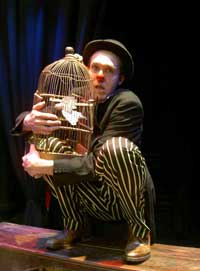
Rather unexpectedly, I find myself taking a 9 week class on clowning.
The particular form of clown that I'll be exploring is a fusion of European and Native American traditions that was founded by Richard Pochinko in Canada. Sue Morrison is his successor; she taught Barnaby King, who'll be my teacher.
Why am I taking the class?
Well, I've been dipping my toe into theater lately... This past fall I was part of a short-lived theater exploration group called "Play." Some of the participants talked about clown... And then I saw Barnaby perform at ScratchPDX and was impressed with his presence... And then I saw a flyer for the class, and had a powerful impulse to give it a try.
During the past year I helped produce a book (Monster Month), and I've been intensely focussed on animating. On a human level, I'd like to spend some time now with an art form that's a little more immediate -- something not so very distanced from living in the moment.
Also, from what I've read online, I see spiritual elements of clown that I deeply resonate with...
"In native American concept of clown, they say that if you ever faced all directions of yourself at once you could just laugh at the beauty of your own ridiculousness. You're already not perfect. You are ridiculous. It's our struggle to be with some status in the world that is ridiculous." --Sue Morrison
"Once Richard spoke in his sleep of being in a spaceship along with others, some that we knew, some we had yet to meet. As we flew over the earth we saw people. At first he thought we were waving. As we came closer, he gasped, 'No, they're trying to get out, they're all inside glass jars struggling to get out. Our mission is to release them, to break down the glass and let them free.'
This became Richard's work: helping people to release themselves. He freed us to face our essential uniqueness and encouraged us to love and celebrate it. He called it the clown." --Gabriel Manseau
Last week I took my first class. Me, being who I am, I naturally had to write up my insights in the form of an essay. I'm sure my understanding will change during the course of the class...
Note: For anyone who might be interested in taking clown classes for themselves, Barnaby says he will be teaching another 9 week class later this summer (as yet unannounced on the website).
A FIRST RESPONSE TO CLOWNING
03.25.08
This is a transcription of what I wrote in my journal the morning following my first Clown Class with Barnaby King. It's unedited, with the exception of adding section headings.
WHAT A CLOWN DOES
"Clown" is about connection -- connecting with the audience. It is a form of improv, where you get up on stage and then react to the moment. However, there can also be composition, where certain points are known in advance. It is not a performance where you are making lots of gestures -- the vast majority of emotion is expressed through the face.
The conceit of the form is that you are turning your internal emotional life inside-out and making it external. It is as if you put every nerve ending on the exterior of your body, so you let yourself react emotionally to every moment and let it all be seen, playing out on your face.
It is not about connecting with the audience only through happy/light emotion -- it is OK and good to allow grim/dark emotions to express, too.
If you bump into a doorway as you're leaving, that's an event -- you don't ignore it and pretend it didn't happen -- you respond to it too.
THE CLOWN RITUAL
How I understand why we do this...
The clown performance is a sort of ritual. The time period during which you're "in clown" is separate from profane time/space; for your brief time on stage you step into a sacred/divine space. [I'm drawing on the title of a book I read in Religion 101 at Reed titled "The Sacred and the Profane.]
The separation between sacred and profane is marked by putting on the clown's red nose -- it is a sacred ritual object. Whenever you put on the nose, there is a tradition that you must also put on a hat. You will be channeling all sorts of gods... Like how in Voodoo a person becomes a "horse" that a deity might "ride." The hat, I think, helps keep you from losing your own personal, profane self to the gods and demons that you let speak through you. If the nose is simply the marker between sacred and profane space, then the hat lets you be someone other than yourself during the ritual -- as if it will baffle the spirits, so they won't recognize you when you take it and the nose off and return to normal space.
But why become a priest? Why initiate this ritual for the village/audience? Because we live life behind armor and faces that are business masks.
We all have a naked emotional self inside of the shell of our body, but the conventions of society don't allow us to let them out to be seen. Each of us is slowly suffocating inside these shells. Many people use the ritual of getting drunk as their ceremonial means of stepping out of the armor... But this strategy has a lot of problems with it.
The clown, by intentionally becoming emotionally naked in front of the audience, gives them a hero which they can briefly empathize with and live through.
When the audience/village give the clown/priest permission to step into divine space, he is also given license to temporarily break the normal rules of society. This means reaching out with the eyes and establishing a real connection with the individuals of the audience. The clown simply reacts to what he is seeing with authenticity -- which can be a profound experience for the person he is witnessing.
PRIVACY BUBBLES
In normal space, there is not only an imaginary bubble around each of us which represents our inviolable personal physical space -- there is also an imaginary privacy bubble around our emotions.
A clown amplifies their emotional presence and connection to the world -- and it is amazing to witness how almost every thought plays out across the face and is truly legible to the audience. To a large extent, this is also true with people living in normal space... Their thoughts and emotions are playing out across their faces at every moment. We think that our faces are neutral until we intend to show something -- but this is less the case than we believe. Even when a person is trying very hard to maintain a poker face, "tells" frequently flit across the face.
In order to keep society running, there is an unspoken contract that we will not react to each other's faces -- the text of what we say out loud is the currency of our social transactions. It almost never happens -- but when someone explicitly reacts to the tone of what we say rather than the text, or starts talking about the emotions on our face, it tends to be experienced as a violation of personal space. The imaginary privacy bubble has been ripped away, and we feel naked and exposed, extremely vulnerable because we can't control the fact that our thoughts are playing out over our faces.
So the emotional privacy bubble exists to give us some safety to think and feel what we do without threat of being called to account. But the bubble also exists because the daily business of living has to get done. When I go to the grocery store, my interaction with the cashier must be formulaic. If I suddenly broke into divine space and connected with them as if I could see their naked soul and they could see mine, and a conversation was occurring... Well, the line of other patrons behind me would get quite irate at the wait.
However, while privacy bubbles are necessary for emotional safety and getting the business of life done, they also have a negative side effect: they increasingly make us feel invisible and isolated. It's as if no one can actually see us -- at least not the "real" us. It becomes lonely inside our armor... And then the crazy notion that we don't really exist can even creep in, as we internalize the apparent message of people ignoring our "real" selves.
Because society has no healthy outlets for darker, more problematic facets of ourselves (rage, jealousy, grief, trauma), the internal censor which helps keep these emotions reasonably hidden inside the bubble can begin to reinforce the boundary with a sense of shame. This is profoundly unhealthy -- and while professional therapy can help allow people to air out their armor, it is also true that professional therapists are required to establish boundaries (e.g. the 50 minute hour, emotional detachment and distance) which can make it difficult or impossible for a client's divine self/selves to come out and be witnessed.
It is also worth noting that some people use the privacy bubbles for personal gain... Knowing that most people accept the convention of only interacting with each other through text, these individuals use tone in malicious ways, and act in the silent spaces for personal advantage. Given how challenging it is to break normalcy and name something that's happening as problematic, it's extremely easy to get away with shit if you're willing to disregard the conventions of polite social transactions.
CLOWN ETHICS
Back to clown. As I've said, the clown is like a priest in a special ritual. He is given license to break the normal rules. He strips off his personal emotional privacy bubble and shows the audience his naked soul reacting to them. This is a profound sort of truth telling... And yet, the clown is not given license to simply say (verbally or non-verbally) whatever comes to mind.
There is an ethics of kindness which must be in one's heart if one presumes to claim the role of clown. Clown is not buffoon, where you make fun of your audience. The clown's ethic embraces all facets of his own personality (and the souls of his witnesses) light and dark, and laughs -- kindly -- at the absurdity of existence.
The clown allows the audience to briefly live through his own emotional freedom -- but also pierces through the fourth wall and the individual witnesses' privacy bubbles, and lets himself really see them too. Being truly seen by kind eyes is a gift to the audience members which, for brief instants during a performance, pulls them out of their stifling armor.
LIFE DURING THE TIMESPAN OF PERFORMANCE
One of the most fascinating aspects of the clown to me is that he is a mayfly...
The clown is essentially born in the instant he steps onto stage -- which is part of how the performer is able to step into their "beginner's mind" (to borrow a term from Zen). But the clown also only lives until they step off stage; stepping into darkness is like letting go and falling into the arms of death. The clown's turn on stage, thus, is a microcosm for living life.
This raises further interesting questions about the quality of interactions with audience members during that brief life in the spotlight. There is the possibility of feeling quasi-romantic/erotic attraction to particular audience members while you're on stage. What do you do with that experience?
In giving oneself permission to expose radical authenticity, it seems that this possibility must be allowed... But there's also a responsibility after reaching out to individuals in the audience to come back into oneself and share what one has felt with the audience as a whole.
Another strategy, besides returning to self-awareness, might be to not exhaust the interaction with whomever you're connecting with, but rather to feel that energy and then move with it to another individual, seeing what happens when the thought is carried along into a new interaction.
It must be kept in mind that the clown's brief divine life on stage is not the same as a profane life. There is an element of composition that occurs, so that when you step out of the stage lights and into the clown's death, there are no promises of more to come. There's no promise to any of the witnesses that "I'll come back and give you more attention later" or "I'll be back for an encore if you clap enough." The clown, due to the psychological requirements for coming on stage entirely in the present of their emotional nakedness, must find contentment with what occurs during their brief stay, and "die" knowing that's all there is to it.
THE ACTOR WHO BECOMES CLOWN
I've written about the clown as priest... But this is only half of the picture -- because there is also the profane person who makes the decision in normal space to let themselves be possessed by clown.
Why do it?
Because there's a selfish motive of wanting to get to take the armor off and feel emotionally alive in a very intense way.
The clown-priest, I think, in essence is a healer... So there's probably a messianic impulse too...
But the theatrical actor who does clown performances probably ought not to give too much credence to the thought that what they are doing is "holy" or "healing" work. The performance is a brilliant moment -- but when it is over, any lasting effect on the audience is almost purely accidental.
The performance is what it is, during the moment it exists, and then it is over. The ritual of clown, therefore, must be undertaken primarily for the sake of enjoying doing it.
posted by sven | permalink | categories: classes & workshops
March 30, 2008
book review: the anatomy of story
by sven at 1:15 am
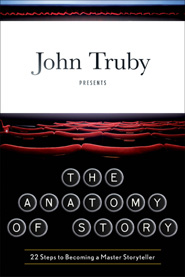
The Anatomy of Story: 22 Steps to Becoming a Master Storyteller by John Truby (2007) is just about 420 pages long. I recommend the first 100... And then to skim the rest.
The core idea of the book is, in my opinion, a good one: In order to create a compelling story, don't simply sit down and start writing... Instead, construct a well-reasoned architecture of story structure -- and then progressively flesh it out.
Frustratingly, though, the book's title is deceptive. The "22 steps" are not steps in your own personal progress toward becoming a storyteller, as one might infer. Rather, the "22 steps" are moments that occur in an archetypal story -- steps that Truby believes your protagonist must go through during the course of their adventure.
And, frankly, these steps are no huge revelation. Here is the grand list:
- Self-revelation, need, and desire
- Ghost and story world
- Weakness and need
- Inciting event
- Desire
- Ally or allies
- Opponent and/or mystery
- Fake-ally opponent
- First revelation and decision: Changed desire and motive
- Plan
- Opponent's plan and main counterattack
- Drive
- Attack by ally
- Apparent defeat
- Second revelation and decision: Obsessive drive, changed desire and motive
- Audience revelation
- Third revelation and decision
- Gate, gauntlet, visit to death
- Battle
- Self-revelation
- Moral decision
- New equilibrium
If you understand what each of these steps in the protagonist's journey represents, how is that going to help you? Well, you can use them to inspire you -- the list might suggest scenes that you hadn't thought to write yet... Or it could be used as a check-list, so you can check to see if there's anything important that you might have left out of your outline...
But in general, I feel this list is too formulaic to be of much real use while actually generating a story. It's an editing tool -- and not a particularly sophisticated one, at that.
As I said at the beginning, the first hundred pages of the book are quite worthwhile, though. Here are a few of the insights that I thought were useful:
- The premise of your story will structure everything else you do. Don't skimp at this stage of the process -- spend weeks getting it right, not just days.
- To help find your premise, make a wish-list of everything you'd like to see in your ideal story. [Chris Baty offers the same advice in No Plot? No Problem! -- and additionally suggests writing a list of all the things you hate in a story, and want to make sure to avoid.]
- Don't develop your protagonist in isolation. Instead, think of your cast as a "character web"... Develop the characters by comparing and contrasting them, so that each one is clearly distinct from all others.
- Everything works toward the climax. Start the story-writing process by figuring out how things will end, then work out the path to arrive there.
- A story progresses through "reveals." Make a list of all the reveals in your story to make sure that they build in intensity -- otherwise the story will lose momentum.
These ideas all occur in the first four chapters. Chapter 9 had another useful idea, "scene weave" -- an editing method, where you reduce the main action of each scene in your story down to a single sentence and review the sequence. [Throughout the book, Truby seems to be in love with the idea of boiling your various concepts down to single-sentence "mission statements."]
I had high hopes for the rest of the book... Chapters titled "Moral Argument," "Story World," "Symbol Web," and "Scene Construction and Symphonic Dialogue" all sounded quite promising -- but instead were painfully tedious.
For wide sections of this book, it is quite obvious that Truby had a book outline that he was working from... He dutifully fleshed out each section that was in his outline... But just because you think you ought to include a topic in your book, doesn't necessarily mean that you have anything insightful to say about it! In these areas of the book, there's no sense that even Truby is excited about what he has to say -- he becomes the most boring sort of lecturer.
Mechanically fleshing out an outline is perhaps a forgivable sin. Worse, though, is that Truby analyzes the same films over and over and over again. Instead of illuminating his ideas, it ultimately feels like Truby is padding his book with synopses.
In the penultimate chapter, pretense of analyzing the films seems to disappear entirely, and the discussion degenerates into mere film appreciation... With Truby heaping praise upon:
- The Seven Samurai - "this is one of the great scripts"
- Butch Cassidy and the Sundance Kid - "...has one of the great openings in movie history, it also has one of the great endings"
- Casablanca - "The final scene...is one of the most famous in movie history"
- The Godfather - "this great film..."
...And so on.
The author spends no time discussing more modest films, or looking at how to take a particular flawed script and improve it. The book blurb claims that Truby has taught his classes to more than "twenty thousand students worldwide." In my imagination, I see this man watching the same great films year after year, developing ever greater appreciation for them... But never writing an original script himself. How could an original work ever live up to the films he seems to worship?
I'm sure my fantasy of Truby is inaccurate and unfair. But I'll say for myself that at the end of the book I was genuinely mad at the author. He abandoned his task of guiding the writer who must generate new, imperfect material, and indulged in simply praising history's "perfect films."
If I'm going to stick with you for all 420 pages, you'd better make it worth my while!
Based on the form-factor and title of the book, I strongly suspect that the publishers want to create a feeling that "The Anatomy of Story" is the unofficial sequel to Robert McKee's Story: Substance, Structure, Style and The Principles of Screenwriting (1997).
I read McKee's book recently, and while I have minor criticisms about it, I feel that it is overall a fantastically clear book -- the first place I'd send anyone who's interested in constructing stories. It's 480 pages -- but it delivered just what it promised.
From what I gather, McKee's book has become something of a bible in Hollywood... I offer a mote of evidence, by quoting a critic of McKee, Mystery Man on Film:
"When people in the biz talk about character arcs, they are talking about a change to the inner nature as defined by the Grand Poobah of gurus whose obscenely invasive influence all throughout HW spans well over a decade now. Right or wrong, love it or hate it, we have to go by Robert McKee’s definition, unfortunately."
Given McKee's standing, it shouldn't be surprising that there will be other story consultants vying to be the next guru... But, in my opinion, after reading "The Anatomy of Story," I believe McKee's book should still be the primary text for aspiring story makers.
Truby's book is an interesting supplement to McKee. Both books share the same core philosophy, which is that story should begin with constructing a solid structure...
My hopes that Truby could build upon McKee's foundation, translating solid story analysis into a trustworthy method for story generation were largely disappointed, though.
posted by sven | permalink | categories: writing
March 27, 2008
greetings from tucson
by gl. at 3:50 pm
we're back from tuscon! toby & gregory were specifically invited to attend sven's brother's wedding. they had a great time: gregory, in particular, likes weddings because people say such nice things. he even blushed a couple of times. toby is the life of the party, of course, but he tried to be on his best behaviour for the special day.
here they are in a postcard moment: drinking "mockaritas" in their new easter ties (thanks, shield!).
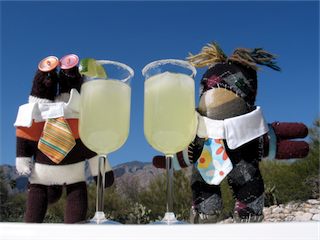
[greetings from tucson]
posted by gl. | permalink | categories: toby
March 22, 2008
artist's way guided intent (march)
by gl. at 9:01 pm
for our march guided intent we explored a wide variety of dreams, as well as events both real and imagined. the studio is a flexible space: all the tables and art were whisked away, leaving a blank "canvas" to hold the stories as they were spun.
over the course of the evening I got to become a baby penguin, a rippling pond, a TV, a woman on the se artwalk, a young man saying goodbye to his mother, a judge in a courtroom drama, friends & family of a grad student, AND a seminar speaker watching her dream come true! some of the stories made us all laugh, while others made the storytellers get misty-eyed and emotional.
since i was participating in the stories that were being told, I don't have a lot of pictures this time, but we re-enacted a few to give you a taste:

[one of the scenes: click the image to see more]
playback theatre involves a storyteller telling ordinary stories and then picking people to re-enact those stories. it's much more moving and fun than that simple description sounds. this is always the hardest guided intent to run because performing arts is so scary to people, so i usually end up having to participate so that we have enough bodies.
we clear the room to make it an empty stage for the actors, but i also want to make a special space for the storyteller. so i was pleased that this time, instead of setting up a makeshift backdrop with two microphone stands and a stick, i scored a folding screen from craigslist the day before. and instead of hauling the large comfy chair over from the house, i finally found that world market carries director's chairs! i've been offering this activity for three years and that's always been my vision for it, so i'm glad that they both "set the scene" for this activity and can be reused for other studio events.
our next guided intent theme is self-protection: by embellishing a soft cloth doll to act as a warrior (or guardian), you can manifest the qualities you want to protect yourself from critics, crazymakers, or anything else that theatens your creative potential. we'll have all the 3D objects out for this and I'm quite sure we'll make a glorious mess. :)
posted by gl. | permalink | categories: artist's way
March 21, 2008
time is money
by sven at 7:00 am
Time-management is a crucial skill for artists as much as anyone else. Here's a metaphor that I find useful to keep in mind.
...Oh, and don't be too put off by the title -- I'm actually trying to reclaim and redefine that nasty old phrase!
TIME IS MONEY
1. Time is money.
Your time is a currency that can be used to purchase things you want.
2. Don't impulse buy -- invest your time.
Rather than doing whatever comes to mind next, consider investing blocks of time toward purchasing things that you really want.
3. Spend money (time) on planning your investments.
Don't over-plan... But a reasonable amount of time spent thinking about how you want to use your time is a reasonable expenditure which will increase your returns significantly.
4. How much time do I have?
Look at the schedule for your upcoming week. Block out the known time-commitments so you can estimate how much free time you have to spend on investments.
5. Make a wish-list of tasks
Make a list of every task you'd like to complete. You won't be able to purchase all of these goods -- but it's useful to have them all in front of you to choose from.
6. How much do my desired tasks cost?
Evaluate a wish-list of tasks, making quick estimates of how much each thing costs. Know that your wish-list will always outstrip your means.
7. Some assembly required.
Most goals don't come in a single package -- they have to be assembled from multiple purchases. Pay careful attention to what all sub-tasks are required in order to accomplish your ultimate goal.
8. To-do lists are shopping lists.
A useful shopping list categorizes items by which store you have to go to, and how high a priority each item is (so you can ditch low-priority items if you're running out of time). To-do lists are often dysfunctional because they don't specify where you have to be physically in order to do the tasks, or don't specify all the sub-tasks required to get you to the point of purchasing the main goal.
9. Track your investment portfolio.
Keep a list of the big projects that you're working on (typically 15-30 in progress). These are like purchases that you're making on an installment plan.
10. Diversify your portfolio.
If you only make plans to invest time in one area (e.g. writing a book), then when your personal economy crashes you're more likely to lose control of that project. If you are investing time in several different areas concurrently, you have a better chance of remaining in control of your life.
11. I am not my money.
I am more than my projects. Even if they all fall apart, I am still OK. I am the catalyst that effects things around me, but which is not defined by them.
12. The purpose of money is to buy more life.
Money (actual dollars) is not an end in itself. It is a means to an end: getting more life. Similarly, all the things that you can purchase with your time may be valuable -- but actually stopping and getting to feel OK sometimes is most important of all.
Note: I wrote this essay last month (2/21) -- it just took a while to get around to posting it.
posted by sven | permalink | categories: writing
March 20, 2008
gnome puppet - tease
by sven at 7:00 am
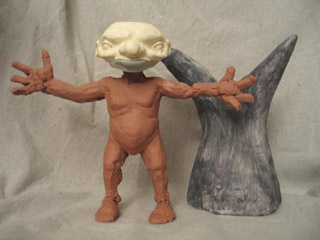
Two weeks ago I was working on a puppet that you saw bits of last year. I had been hoping to hit the March 31 deadline for the StopMoShorts.com stopmo haiku challenge.
What was I thinking?! All my time needs to be going toward getting Let Sleeping Gods Lie done! So, the project's back on hold.
But I figured I give you a little tease. ;-)
The gnome's body is being sculpted in Chavant NSP. The idea is to cast it in foam latex.
The head is a resin casting. It's detachable; there's a K&S plug-in in the neck.
I shaved off the lower jaw with an X-acto blade. I created a new lower jaw using Magic Sculp epoxy clay, which attaches using two 1/8" brass pins. The idea is to sculpt several further lower jaws, so the pup can do lip-sync.
My most ambitious puppet yet. And I'm just aching with frustration, knowing that I mustn't spend time on it until... Well, the H.P. Lovecraft Filmfest submission deadline this year is August 15. Could be as long as that.
Oh -- And the tree... The tree in the background is plaster over insulation foam, with a wash of acrylic paint. Something that I made at a plaster workshop led by Stephanie Lee, which I attended in February.
posted by sven | permalink | categories: stopmo
March 19, 2008
What makes a great stopmo film?
by sven at 7:00 am
[I wrote this on 2/22 in response to this thread at SMA. Seemed worth cross-posting.]
What makes a great stopmo film?
I think there are (at least) two competing meanings for the word "great" here. On the one hand, "great" might mean "excellently made" -- good puppets, smooth animation, a delicious color palette and intriguing forms... On the other hand, "great" might mean "serious art" -- the sort of stories that get published in collections of "the world's greatest animation," etc.
I want to try to say something about stopmo that aspires to being "serious art."
STOPMO STORIES' MOST COMMON ELEMENTS
I did a quick survey of my stopmo DVD shelf, asking "what elements do these films have in common?" What I found was that the vast majority use stopmo to accomplish a fairly limited number of effects. These include:
- dinosaurs - Lost World; Beast from 20,000 Fathoms; Planet of the Dinosaurs
- dragons / mythological monsters - Jack the Giant Killer; Clash of the Titans; Dragonslayer
- modern horror monsters - The Thing; 7 faces of Dr. Lao; Nightmare Before Christmas (not necessarily scary monsters)
- space aliens - Star Wars holo-chess; Jason of Star Command; First Men In The Moon
- robots - Robo-Jox; RoboCop; AT-AT Walkers; Star Crash
- skeletons - Jason and the Argonauts; Corpse Bride
- insects - The Cameraman's Revenge; James and the Giant Peach; MTV's Monster Island
- talking animals - Wind in the Willows; Creature Comforts
- living toys - Starewicz's 'The Mascot'; Robot Chicken; Domokun
- inanimate objects moving - Street of Crocodiles; the works of PEZ
- morphing - The Adventures of Mark Twain
- rubbery cartoon-style people - George Pal's Puppetoons
- stringless marionettes / puppets - Trnka's 'The Hand'
When I go down this list, what I see is that most of these elements force a story into a genre: science fiction / fantasy, children's, or comedy.
What is a "genre" film? One that has certain guaranteed elements that the target market expects when they purchase your product. A western, for instance, has to have cowboys, horses, six-shooters, and hats. A murder mystery has to have a murder that gets solved. A romantic comedy winds up with the protagonists essentially getting married.
Frustratingly, genre stories are almost never considered serious art. There are a few interesting exceptions, where genre stories transcend -- but more about that later.
ELEMENTS OF THE "SERIOUS ART" GENRE
I recently watched the new "Animation Show of Shows" DVD sets. The DVDs have some pure comedy pieces mixed in -- but there's also a high proportion of "serious art" shorts. When I consider them as a group, what I see is that "serious art" is essentially a genre itself -- you just have to recognize what the "marketable" elements are in this case:
- the familial life cycle - children losing their parents and becoming parents themselves
- the sexual life cycle - being born, falling in love, having sex, procreating
- aging - how approaching death shifts perspective
- loss / grieving for the departed
- embracing / avoiding one's own death
- questioning the nature of death / afterlife
- creation myth re-tellings
- coming of age - taking charge of one's destiny
- being a part of war-making
- technology vs. nature
- Freudian / Jungian divisions of the psyche
If your animation project deals with one of these themes, you're pretty much automatically in the realm of "serious art." It almost seems unfair, realizing that there's a formula...
TRANSCENDING GENRES
Now, returning to films that transcend genre... I think King Kong (1933), Star Wars, and Suzie Templeton's Peter & the Wolf are more than just a Giant Monster movie, a Space Opera, and a Children's Fable.
Why? Well, the original Kong is a psyche story, where Kong is the stand-in for masculine libido. (Peter Jackson, really screwed up this aspect of the story, which imho is part of why his film didn't work nearly as well as the original.) Star Wars has amazing spectacle -- but it's really the spiritual element of Zen vs. Technology that gives us a compelling world view. Suzie Templeton -- well, everything that she's done is just dripping with Freudian psychology.
...
So, what makes a great stopmo film? Here's my answer: Yes, pay attention to the technical and artistic details of good filmmaking... But if you want a shot at being considered "serious art," then take care when choosing your theme. Pick one that makes a broad statement about human nature / the human condition.
That is, if the "serious art" market is who you're really moved to speak to.
posted by sven | permalink | categories: stopmo
March 18, 2008
halfway between puppetry and puppetfilms: pop-thru animation
by sven at 7:00 am
Wrote this last week Sunday (3/09) when the idea was burning a hole in my brain. Probably not as cool as I thought in the heat of the moment -- but still worth sharing. Sorry there's no accompanying video clip yet.
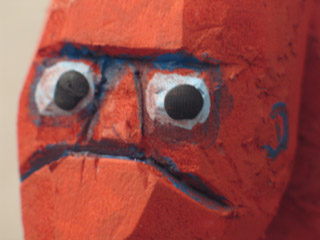
Sometimes I wish I could use stopmo as if it were a 4th-dimensional sketchbook... Quickly and loosely "sketching" sculptures into existence that could then move on their own...
I'm thinking that maybe pop-thrus could help accomplish this wish.
What if a pop-thru were then presented as if it's a complete film? Based on a few related films that I've seen, and on how people relate to live puppetry, I suspect the audience would look past the flaws and accept it.
But would other stopmoes accept rough and stuttery pop-thrus as "real" stop-motion animation? Case in point, would StopMoShorts.com accept a film that looks like this?
I think I could make a strong case that pop-thru animation should be considered a legitimate form of puppetfilm -- that it just uses a very stylized form of motion.
When I look at the broader context, it seems to me that pop-through animation could do something interesting. Puppetfilms exist on a continuum halfway between live puppetry and traditional hand-drawn animation... Exploring pop-thru animation could push stopmoes more toward thinking of themselves as puppeteers, rather than animators.
Exploring unfamiliar territory like that has just got to produce some interesting results...
1. THE PROBLEM: STOPMO TAKES A LOT OF TIME
Puppet animation takes a lot of time. Building the Professor Ichbonnsen puppet for my last film took 24 hours. When you add in building the set, recording the script, animating, and doing post-production, then I'm sure it took 3-4 times that long to produce the final 30 second clip.
I'm OK with that. I like pouring focused attention energy into art. But there are also times when I wish I could produce my visual ideas more quickly. I fantasize about stopmo being more like my sketchbooks... More like throwing ideas out fast and furious with a pencil and paper.
It's hard to take risks and grow as an artist if every experiment is so expensive.
True, I can explore ideas pretty quickly by drawing storyboards... But it's not really satisfying. It's not three-dimensional; the sense of forms, volumes, and space that I see in my head don't translate.
So I'm on a quest. I want to find ways to make stopmo feel more like sketchbooking. ...Not as the only thing I do -- but as one available option.
2. FINDING A NEW FAST AND EXPRESSIVE STYLE
So, quest in mind, I set myself a goal: Find a way to build a puppet in one hour. It's OK if it's rough around the edges -- but it has to be actually functional for animation.
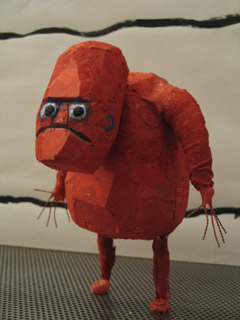
Here's the result. It took two hours to build -- but still, that's pretty good. And what's more, I genuinely like the look. The deliberately rough-hewn edges feel like they've got life in them.
With some initial success, now I'm thinking: How can I animate my puppet in a way that's equally fast... But which still captures the essential ideas of my vision?
There's an obvious answer: Do a pop-thru.
A pop-thru is an exercise pro-animators sometimes do, where they photograph their key poses but leave out all the inbetweens. It's usually only done during feature productions, when demanded by the director -- it's not something anyone usually keeps around for it's own sake.
But what if you did? What if you treated a pop-thru as your final product? I've experimented with films told through a series of still photographs, and they seem to work OK. And I've seen a few short segments on TV that do the same thing. If there's a worthwhile story, the audience seems to be pretty darned forgiving about how it's presented.
I think to myself: YES -- this is what a "stopmo sketch" must look like. It's not just "test" -- you can do a whole story in this style. And it's not necessarily sloppy -- you can put focus into choosing strong poses. I think artistically, this could really work!
3. IS IT ANIMATION?
Using pop-thru animation would make it much more feasible to get a short done in time for the March 31 StopMoShorts.com "stopmo haiku" challenge. And when I think about submitting pop-thru animation, it excites me... Because it feels like it could expand people's horizons about what can be done with stopmo. But I also anticipate a backlash: people feeling that what I've done isn't actually "real" animation.
Not real animation? When I look at the tools that I'm using, the pop-thru is almost identical to any other stopmo film. I'm using gestures, key frames, X-sheets, puppets that have no visible connection to a puppeteer... Really the only difference here is that I've eliminated the inbetweens.
Perhaps someone will suggest that it's not really animation -- it's pixilation.
I think I'd disagree with this. The quintessential pixilated film has to be Norman McLaren's classic, "Neighbors." How is pixilation used in this film? Live actors are shot in static poses which then get strung together into a film. They pop around as if being filmed by time-lapse photography -- although the critical difference there, I believe, is that the camera's shutter is not being triggered on an automatic time-schedule -- the director has as much time as they need to pose each shot.
A pop-thru isn't made using live actors who can pose themselves -- there has to be an animator involved, putting the puppets into their positions. So, I'm inclined to think that a pop-thru isn't "true" pixilation; a pop-thru is simply a pop-thru.
It is its own unique thing -- and it is animation. It requires an animator and an animator's tools. What else could it be?
4. BUT CAN WE ACCEPT IT AS LEGITIMATE STOPMO?
Even if people are willing to accept that the pop-thru is really a form of animation, I expect there may still be some resistance to accepting it as legitimate stopmo.
Why? Because the inbetweens are missing? I think there are some relevant precedents worth looking at...
In the realm of traditional hand-drawn animation, there's what's called "limited animation." Hanna-Barbera is a good example of this style. Constrained by budgets, animation houses were forced to stop drawing every frame of a cartoon, and instead used a lot of "talking head" shots and recycled walk sequences.
I've noticed that animation festivals sometimes accept shorts from 2D animators where it's just their pencilling -- no inking or coloring has been done. These shorts don't look "finished" -- but they're entertaining and worth watching as-is, nonetheless.
I think about the Academy Award-winning "Harvie Krumpet" and Adam Elliot's other stopmo works -- which for the most part are shots of the main character standing still.
Limited animation, unpolished animation, and animation that has a lot of still shots -- these all, nonetheless, generally aspire toward a sense of realism. Pop-thrus break with realism more noticeably, due to their stuttery rhythm.
But there are different aesthetics for motion. Ray Harryhausen aimed at a photo-realistic smoothness... Robot Chicken aims for exaggerated "pop"... And what about the Brothers Quay? They have a uniquely non-realistic approach to motion (e.g. the blurry skeletons in "Frida") -- yet no one would suggest that what they do is not proper stopmo.
My conclusion is that though pop-thru animation may look relatively "unfinished" and stuttery, it properly belongs to the family of stop-motion puppet animation. It simply has its own unique aesthetic for motion.
5. THE AUDIENCE PARTICIPATES IN BRINGING PUPPETS TO LIFE
Let me take an unexpected turn now, for the sake of explaining why I think pop-thrus' motion aesthetic can work with an audience.
Puppet animation requires skills from many different art forms: sculpting, puppet-making, model-making, photography, acting, animation...
I think puppetfilms' closest relatives, though, are hand-drawn animation and puppetry. I think you could say that there's a continuum between these two extremes, and puppet animations sits right there in the middle.
I find this interesting: Stopmoes, we call ourselves "animators" -- not "puppeteers." But we could just as well call ourselves puppeteers, since our acting has to be transfered through our puppets... For that matter (to a lesser extent) puppeteers could call themselves animators -- since they invest life into inanimate puppet beings.
So, how are live puppetry and puppet animation really different?
Well, the most obvious difference is that that stopmoes manipulate their puppets during the invisible space between frames of film. From the audience's point of view, we are physically divorced from our puppets in a way that live puppeteers never can be.
But I think there's something more than this. When I think about all the different types of puppetry... Marionettes, Muppets, sock puppets, ventriloquist dummies, giant Bread and Puppets figures, Indian shadow puppets, and so on... What I notice is that the illusion of reality requires a greater suspension of disbelief.
Puppeteers may mask their presence by dressing in black, or hiding below the proscenium of the puppet stage -- but to forget that they are there, the audience must willingly play along. Skilled puppeteers can create stunning subtlety in their performances -- and yet, few puppets can actually capture a full range of human emotions on their faces. The audience participates in bringing the characters to life, using their imaginations to help isolate and animate the story.
This is what I'm asking the audience of pop-thru animation to do. Here's the deal: I'll give you the key poses -- you use your imagination to fill in the inbetweens for me.
I think this can work... Puppet shows don't seem to suffer from presenting imperfect illusions of reality -- if the story's interesting, the show's a hit. The same should be true for pop-thrus.
6. EXPLORING THE BORDERLANDS BETWEEN PUPPETRY AND PUPPETFILMS
If there is a continuum between live puppetry and hand-drawn animation, then stopmo puppetfilms sit squarely between the two. If we try to place pop-thru films on the same continuum, then I think they fall halfway between live puppetry and puppetfilms.
An illustration might help here. Imagine a continuum that runs from 1 to 9. Here's where I'm suggesting these art forms would fall on it:
- hand-drawn animation
- stopmo puppetfilms
- pop-thru animation
- live puppetry
There's plenty enough to learn if you just want to become good at stopmo. But I think it's well worthwhile for the serious stopmoe to also make forays into the the realms of hand-drawn animation and live puppetry.
Back during the 1930s, the animators at Disney discovered and articulated core principles of animation: squash and stretch, secondary motion, follow-through, etc. In the world of of animation -- hand-drawn, flash, CG, stopmo -- no one surpasses the understanding of motion mechanics that the pencil-pushers have attained. We would be wise to learn from them.
Puppetry, on the other hand, has life and vitality to it that is difficult to feel in oneself one frame at a time. Live puppeteers strive to be actors -- but unlike live action actors, the performance has to be channeled through an inert figure made of wood, foam, wire, and cloth. Because puppeteers don't have to also simultaneously struggle with animating, they've made strides in the art of expressiveness that stopmoes generally take longer to discover. Once again, we would be wise to learn from this other realm.
There are arenas where setting hard lines between art forms is necessary. For instance, the question of whether or not motion-capture constitutes animation has bearing on who's allowed to compete for a "best animation" Oscar this year...
But in the realm of creativity, exploring the borderlands between neighboring artistic nations should be encouraged. Digging around in the gray areas between black and white will surely lead to unusual discoveries -- which have the potential to re-enrich our native traditions.
On the grandest scale, this is part of what I think pop-thru animation has the potential to do.
I want to take what has been a mere exercise, and expand it to become a full-fledged style of animation...
Pop-thru animation may look rough, it may look stuttery -- but I think it can open up a freedom for me to explore sculptural forms and story ideas that I would not otherwise risk investing in.
I'm thinking this out loud, because I want to open this exploration up as a possibility for other animators as well. What I see in pop-thrus that could benefit me -- maybe it could be useful to you too.
Let's call it legit and find out.
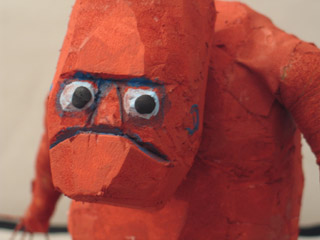
posted by sven | permalink | categories: stopmo
March 17, 2008
lsgl - stopping at 171 pages
by sven at 1:30 pm
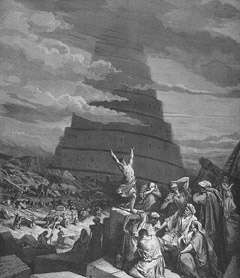
I've finally found a way to tell Act II of Let Sleeping Gods Lie that I think I can live with. Basically, I want to make a visual reference to the Tower of Babel and then do two tableaus: "before" and "after." ...But with pterodactyls.
This approach won't require too much time spent fabricating new elements... It's a good, terse bridge between acts I and III... It's visually distinct... I think there's a lot going for this solution.
And boy am I ready to quit doing story development through writing for awhile! So far in 2008, I've written 171.5 pages of brainstorming -- 91,884 words. For comparison: Lovecraft's original novella, At The Mountains Of Madness, is only 41,284 words long. So in trying to adapt his story, I've gone and written a body of text 2.23 times as long as the original. Madness indeed!
Here are my most recent 53.5 pages of exploration:
- March 6 - 12 pages
- March 7 - 5 pages
- March 11 - 10 pages
- March 12 - 15 pages
- March 13 - 7 pages
- March 14 - 4.5 pages
When I get back from my brother's wedding, then I'm on to fabrication!
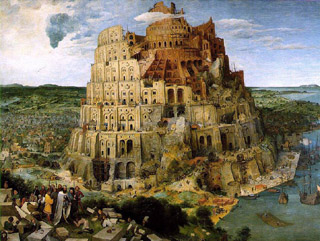
posted by sven | permalink | categories: let sleeping gods lie
March 11, 2008
recent events
by gl. at 2:42 pm
march is also a busy art month!
we went on the se artwalk, though i was sick so i went back to take a nap in trixie while sven talked to the pacific northwest sculptor's guild. but i did get to see shawn, trillium, mandy & alisa. i picked up a bowl from georgine longfellow and ought to have picked up shawn's "night ride" monoprint.
later that night we went to linda womack's "leap party". linda quit her day job to become a full-time artist, and held a party on her first day of freedom, mar01. i gave her a "leap and the net will appear" wordwear necklace, but could only stay long enough to eat a little cake before i had to go home and collapse.
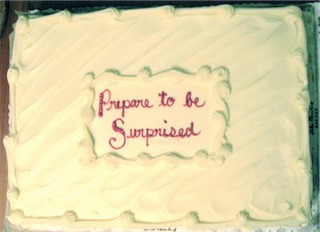
[linda's cake: prepare to be surprised]
i was feeling better by the next friday, so we went out to see some art shows. first we had a bite to eat at screen door (great mac & cheese!). then we stopped by 100th monkey to see their art therapy show, since creative arts therapy week is this week. then we stopped by art of your life because i suspected emma would be showing at the student show there, and she was! then we stopped by bite studio to see shawn's "stories" show and emma showed up to that, too!
whew! but now i'm sick again. i didn't go to the craft party at twisted or the art therapy afternoon tea on sunday, and an artist's way client just dropped off a deposit this afternoon and found me bundled on the couch in blankets wearing two sweaters, a hat & a scarf. i hope i feel better soon!
posted by gl. | permalink | categories: exhibits & events
March 10, 2008
mistaken identity
by gl. at 2:11 am
this is just administrivia, but i tweaked the blog template so it's more obvious who's writing which posts, me or sven. :) also, i made the link to individual post pages more obvious (permalink) and linked our names at the bottom of each post to a rudimentary profile page until i figure out how to tell movable type to generate a page with all of the posts from one author.
posted by gl. | permalink | categories: administrivia
March 8, 2008
the process of development
by sven at 3:38 pm
I've been doing huge amounts of work on story development for "Let Sleeping Gods Lie" lately. It has me thinking about the process of artistic development in more general terms. I wrote this reminder list last Friday (2/29).
THE PROCESS OF DEVELOPMENT
1. Make art you love.
Why make art? To sell something? To get it "right"? (By whose standards?) Whatever it is that you're working on, aim at making something that you yourself love. Give yourself the room and resources it takes to make that happen.
2. You will discover your solution by accident... But not your first accident.
The art pieces you'll truly love are things that you haven't even met yet. It's not going to be through pure design that you find something that moves you -- you're going to stumble on it. But it's also not going to be the first thing that you stumble on... You're going to need to make lots and lots of discoveries.
3. Make copious explorations.
Don't wait for inspiration to find you -- go out looking for the "Ah-ha!" moment. If the vision for an art piece you love is a discovery, then go and search everywhere for it.
4. Find your vision using cheap/fast methods.
The fastest tools an artist has tend to be the pen and pencil. If you're making sculptures or paintings, sketch hundreds of thumbnail drawings. If you're an author or filmmaker, write pages of stream-of-consciousness and brainstorming lists. (If you can type, then by all means...)
5. Set goals for quantity of development work.
I hate rush and compromise and flailing about, feeling like I'm making crap because I don't really know what I'm doing. But the opposite of this is not to be leisurely, letting inspiration wander in on its own time. Work hard. Decide to write 50 pages of story development in a week, or draw 24 pages of sketches over three days.
6. You can't know what you're going to get out of the process -- it's a risk.
Quantify success in terms of the number of pages you'll produce or hours you'll put in writing/drawing -- not in terms of whether or not you've found the final answer that you can love. When you commit to investing time in a development process, the point is to stumble upon discoveries. Even after 50 pages, you may well find that you need to apply the exercise again in order to get where you're going.
7. Give yourself freedom to go on digressions.
If you feel like you have to go directly from point A (problem) to point B (solution), you're going to feel stressed out. Allow yourself the freedom to go on digressions, trusting that they will ultimately loop back around to the main cause. Beautiful solutions are almost always surprises... You're most likely to find them off the beaten path -- not on the road you thought you needed to travel.
8. Trust that your solution will come to you.
There's a fear of wasting time. When you decide to employ a development technique like writing or sketching, you can't know whether or not it will actually yield a solution you love... So in committing to the process, you're taking a risk. The way to get rid of that nagging fear is to acknowledge that what you're doing is an experiment that may fail. But it's a worthwhile gamble. Trust that the process is worthwhile, and that if you apply your intelligence and imagination long enough (possibly much longer than you initially anticipate) then you WILL inevitably find possibilities -- interesting possibilities -- that you had not initially conceived of.
9. Every dead end you discover narrows down the options.
You're going to find one unusable idea after another... But these are not worthless ideas -- they are immensely valuable. Every one you find helps narrow down your options.
10. Ultimately only one perfect / possible solution will remain.
Art pieces are solutions to problems. How do I express this emotion? How do I tell this story? How do I convey this thought visually? Finding the art that you truly want to make, a vision that you want to take to your final medium, is a matter of finding as many possible solutions as you can and then selecting the one you like best. ...Execution of the idea in the final medium will have it's own challenges -- but if you love the idea, even a flawed end product will be meaningful.
11. Make bad art too.
There is a reason to make art that you DON'T love, too. Sometimes there is an externally imposed deadline that you want to meet -- a challenge. The job in this case is to make the most impressive, technically advanced, creatively outrageous solution you can, given the time available. In this case, set out with the idea in mind that you are making "bad art"; it'll free you up to live happily with experiments that don't live up to the standard of "art you love." You'll grow through engaging with the challenge -- and that's enough... That's a success.
posted by sven | permalink | categories: writing
March 6, 2008
artist's way open studio (february)
by gl. at 5:16 pm
yes, yes, february! as i told dayna, it's never too late to post. :)
several regulars introduced new friends to the studio and the excitement about the previous night's eclipse was still strong. we were so energetic we created 17 (!) shining collages that night.

["penumbra": click the image to see the other collages]
next week we'll celebrate our third year of open studio collage night w/ cupcakes. yay!
posted by gl. | permalink | categories: artist's way
March 5, 2008
lsgl - 50 more pages
by sven at 9:49 pm
In February I challenged myself to write 50 pages of story development in one week. Without too much pain, I met the goal.
It was such a valuable exercise, I decided to go through the process again. So, last week I wrote another 50 pages.
This brings me to a total of 118 pages of story development work so far this year. ...All for a sequence that should be less than 2 minutes long on screen!
For the exceptionally curious (hi gl.!), here's what I wrote:
- February 26 - 17 pages
- February 27 - 11.5 pages
- February 28 - 15 pages
- February 29 - 7 pages
My statistics this time around... I wrote: 50.5 pages -- 26,537 words -- in 18:20 hours, over the course of four days. My averages: 2.75 pages per hour, 527 words per page, 1448 words per hour. (A little slower than last time.)
The writing led to an exciting new way to tell my story. So, this week I've switched to doing visual brainstorming in a sketchbook.
...Which has led to the discouraging realization that I don't think I've truly got the story nailed yet. Back to writing again?
posted by sven | permalink | categories: let sleeping gods lie